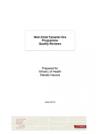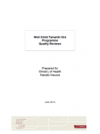The Well Child / Tamariki Ora programme (WCTO) provides a universal health assessment, health promotion and support service for children and families/whānau from birth to five years. The WCTO programme is also an important gateway to targeted and specialist health, education and social services for children and families/whānau with additional needs. Following a comprehensive evaluation in 2007/2008, the content, timing and flexibility of core and additional WCTO contacts were changed. In 2012, the Ministry of Health commissioned a review of how well these changes were adopted and what impact they were having on child health outcomes.
The review was prioritised into the following three areas.The content and implementation of the four-to-six week checks of mothers and babies The three new WCTO assessment tools: PEDS, Lift the Lip and the WHO Growth Charts. The content and implementation of the B4 School Check.
Purpose
The purpose of this quality review was to review the content and implementation of the Well Child checks conducted at around six weeks, to inform the ongoing policy, delivery and quality improvement of these checks and related services delivered to mothers and babies in the early postnatal period.
Methodology
A mixed method data collection process was used to inform the quality review of the 4 – 6 week checks including: literature review, discussions with international and national experts and key WCTO stakeholders, DHB stocktake and survey, WCTO provider survey, analysis of WCTO data from WCTO providers, GP survey, case study of service delivery in three District Health Boards (DHBs), focus groups with Māori, Pacific and Pākehā parents in Christchurch, Counties Manukau and Taranaki DHBs, and input from an Expert Advisory Group. Data collection and the review were conducted between February and June 2012.
Key Results
There was a strong rationale for the timing and content of the B4SC. There was limited evidence for the efficacy of B4SC components for vulnerable populations, in particular, Māori, Pacific and high-deprivation families and whānau. There was variable coverage and referral rates across locations, providers and ethnic groups. Improvements could be made to the content, delivery, accessibility and cultural appropriateness of the B4SC. The findings and recommendations presented in the report reflect the status of the WCTO programme at the time of the reviews (2012). Many of the issues identified in the report have already been addressed by WCTO and B4SC providers, district health boards and the Ministry of Health through policies such as newborn enrolment, B4SC performance monitoring and the development of the WCTO Quality Improvement Framework and Quality Indicators in 2013. Recommendations are also being addressed through initiatives such as WCTO Quality Improvement Programmes, shared information system projects and the Children’s Action Plan. This report is being published as background to recent national and local WCTO Quality improvement Programmes underway in every district health board or region, and to inform WCTO stakeholders regarding areas for further improvement.


